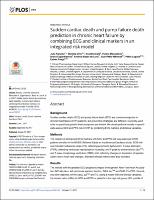Por favor, use este identificador para citar o enlazar este ítem:
https://repositorio.usj.es/handle/123456789/297
| Título : | Sudden cardiac death and pump failure death prediction in chronic heart failure by combining ECG and clinical markers in an integrated risk model |
| Autor: | Ramírez, Julia

Orini, Michele 


Mincholé, Ana 


Monasterio, Violeta 


Cygankiewicz, Iwona 

de Luna, Antonio Bayeas Martinez, Juan Pablo 

Laguna, Pablo 

Pueyo, Esther 


|
| Palabras clave : | T- Wave alternans; Rate turbulence; Postinfarction patients; Mortality; Repolarization; Epidemology; Restitution; Dispersion; Therapy; Stratification |
| Fecha de publicación: | 11-oct-2017 |
| Editorial : | PUBLIC LIBRARY SCIENCE, 1160 BATTERY STREET, STE 100, SAN FRANCISCO, CA 94111 USA |
| Citación : | Ramírez J, Orini M, Mincholé A, Monasterio V, Cygankiewicz I, Bayés de Luna A, et al. (2017) Sudden cardiac death and pump failure death prediction in chronic heart failure by combining ECG and clinical markers in an integrated risk model. PLoS ONE 12(10): e0186152. https://doi.org/10.1371/journal.pone.0186152 |
| Resumen : | Background Sudden cardiac death (SCD) and pump failure death (PFD) are common endpoints in chronic heart failure (CHF) patients, but prevention strategies are different. Currently used tools to specifically predict these endpoints are limited. We developed risk models to specifically assess SCD and PFD risk in CHF by combining ECG markers and clinical variables. Methods The relation of clinical and ECG markers with SCD and PFD risk was assessed in 597 patients enrolled in the MUSIC (MUerte Subita en Insuficiencia Cardiaca) study. ECG indices included: turbulence slope (TS), reflecting autonomic dysfunction; T-wave alternans (TWA), reflecting ventricular repolarization instability; and T-peak-to-end restitution (Delta alpha(Tpe)) and T-wave morphology restitution (TMR), both reflecting changes in dispersion of repolarization due to heart rate changes. Standard clinical indices were also included. Results The indices with the greatest SCD prognostic impact were gender, New York Heart Association (NYHA) class, left ventricular ejection fraction, TWA, Delta alpha(Tpe) and TMR. For PFD, the indices were diabetes, NYHA class, Delta alpha(Tpe) and TS. Using a model with only clinical variables, the hazard ratios (HRs) for SCD and PFD for patients in the high-risk group (fifth quintile of risk score) with respect to patients in the low-risk group (first and second quintiles of risk score) were both greater than 4. HRs for SCD and PFD increased to 9 and 11 when using a model including only ECG markers, and to 14 and 13, when combining clinical and ECG markers. Conclusion The inclusion of ECG markers capturing complementary pro-arrhythmic and pump failure mechanisms into risk models based only on standard clinical variables substantially improves prediction of SCD and PFD in CHF patients. |
| URI : | https://repositorio.usj.es/handle/123456789/297 |
| ISSN : | 1932-6203 |
| Aparece en las colecciones: | Artículos de revistas |
Ficheros en este ítem:
| Fichero | Descripción | Tamaño | Formato | |
|---|---|---|---|---|
| journal.pone.0186152.pdf | 2,34 MB | Adobe PDF |  Visualizar/Abrir |
Este ítem está sujeto a una licencia Creative Commons Licencia Creative Commons

